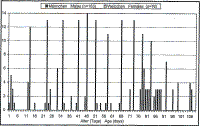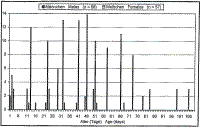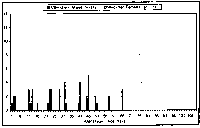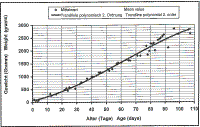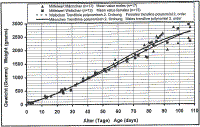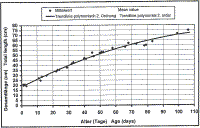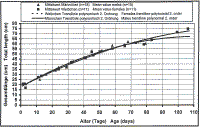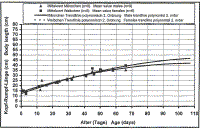 |
Last Update:
Thursday November 22, 2018
|
| [Home] |
|
IUCN/SCC Otter Specialist Group Bulletin Volume 16 Issue 1 Pages 1- 57 (April 1999) Citation: Reuther, C. (1999) Development Of Weight And Length Of Eurasian Otter (Lutra Lutra) Cubs. IUCN Otter Spec. Group Bull. 16(1): 11 - 26 Development Of Weight And Length Of Eurasian Otter (Lutra Lutra) Cubs Claus Reuther Aktion Fischotterschutz e.V., OTTER-ZENTRUM, D-29386 Hankensbüttel, Germany (Received December 18th, 1999, accepted April 25th, 1999)
INTRODUCTION Eurasian otters (Lutra lutra L.) in captivity have non-seasonal breeding behaviour (REUTHER, 1991). This seem to be true also for wild otters in most parts of the species' range in Europe (REUTHER, 1993). Parameters are needed for age determination if otter cubs are found dead, injured or orphaned. HEGGBERGET (1996) published criteria for assigning approximate age in months of cubs up to 6 months of age based on opening of eyes and dental development. Measurements of weight and length over a period of 107 days are available for 32 cubs born since 1979 in the enclosures of Aktion Fischotterschutz. It is hoped that publication of these data will assist age determination of L. lutra cubs up to the age of 3.5 and encourage other institutions breeding otters to take similar measurements to increase the database for statistical analysis. MATERIALS AND METHODSAktion Fischotterschutz has kept otters in captivity since 1979 (Otter Research Enclosure Oderhaus 1979 - 1988, Otter-Zentrum Hankensbüttel since 1988). In the period 1980 - 1998 14 litters were born, totalling 31 cubs (Table 1). Measurements of weight and length could be taken from 30 cubs. Unfortunately it was not possible to take all measurements (weight, body length, total length) from all cubs at all times (Figures 1, 2 and 3). Minimising disturbance to females and cubs was a guiding principle and, therefore, data recording was limited by the behaviour of the animals. Female behaviour varied individually, and from litter to litter. The facilities of Aktion Fischotterschutz do have the advantage that all litters were born in breeding-boxes were the animals can be observed by video-cameras or by microphones.
Measurements were usually taken when the female left the breeding box for her evening feed. The sliding door of the box was closed as noiselessly as possible, allowing the cubs to be handled for some time, unnoticed by the mother. The time taken for the mother to try to return to the cubs and find the door shut varied from female to female, but, in general, increased with the age of the cubs. With advancing age the cubs' reactions became the factor limiting the time available for taking measurements. In their second month the chance of them screaming or whistling increased and once they reached 80 days most of them started biting. Increasing activity and aggression of the cubs caused problems, especially in measuring length. In many cases it was not possible to hold the animals straight - even if two people worked together. Therefore fewer, less reliable, lengths than weights were recorded. In most cases the total length from nose to tip of tail was measured. In some cases body length from nose to base of tail only, or additionally, was measured. This was done using a tape graduated in centimetres and millimetres, placed dorsally on the animal's body. Readings were taken to the nearest half centimetre. Two types of balances were used to weight the cubs. Up to a weight of 1000 grams in most cases it was possible to use a digital balance showing the weight in grams. Once the cubs were older than 40 days and exceeded this weight they were weighed in a bag hung on a spring balance graduated in units of 10 grams; weight being given to the nearest 10 grams. RESULTSWeight
Total length
Body length Only 48 measurements (27 male, 21 female) of body length are available from 14 cubs from the first 66 days of life (Figure 8). This curve shows a more constant 3-5 cm increase in length per 10 days.
As is shown in Figure 9 there is little difference between the 8 males and 6 females.
Because of the small and heterogeneous database extensive statistic analysis was not possible. As stated the intention of this paper is to show trends and to encourage other institutions to collect comparable data to widen the database. As was obvious from Figure 1 the 229 records of weight form the basis for the trend for weight increase during the first 107 days of life, but the ratio of data for males and females is inadequate for analysis of sexual differences. The spread of the data is not optimal for analysis of development over time. Lastly the number of litters is too small for a comparison of differences in weight increase related to the number or sex ratio of cubs in the litter or the influences of different parental combinations on the development. The data so far available does not indicate a significant difference related to the latter factors. There have been all female litters, which are heavier than all male litters and vice versa. The weight of single cubs is not automatically heavier than twin or triplet cubs, but in the 4 mixed sex litters males were heavier than females, individually and on average. However these are preliminary data (Figure 10).
It is too early for a detailed analysis of the increase in length for two reasons; as described in the methods measurements of length are less reliable than weights and the data is not evenly spread over time, with the few recorded after 79 days being for females only (Figure 2). Figure 3 shows that the data for body length are even fewer and relate only to the first 66 days. These data are published at this stage because, incomplete as they are, it is better to have some guide to estimating age of otter cubs than to have none. Using the curves given in Figures 4,6 and 8 it should be possible to estimate the age of orphaned wild cubs younger than four months with an accuracy of plus or minus 10 days. For older cubs the age determination criteria given by HEGGBERGET (1996) will be useful. When using these data for an estimation of the age of cubs found in the wild it should be kept in mind that in many cases cubs might have lost weight before being found. This can happen very rapidly. GREEN (pers. comm.) found a decrease of weight in two orphaned cubs from 210 to 190 and 240 to 170 grams respectively during the first day after they were found. The second reason for publishing these data is to encourage other institutions breeding L. lutra to measure their cubs and share the data. Although only 10 % of institutions participating in the Eurasian otter studbook are successfully breeding the species, in 1996 the birth of 47 cubs was registered in the EEP annual report (MELISSEN, 1998). If only a few of the institutions involved were able to measure their cubs without undue disturbance the amount of data available would be much greater. It is not worth risking the lives of animals to obtain data so measurements should only be made if the risk and disturbance is minimal. However, recording data from stillborn cubs or those dying after birth, should be mandatory. If information is sent to Aktion Fischotterschutz to expand the database additional data required are: - sex, exact date of birth, date of measurements, weight in grams, total and body length in centimetres, information on circumstances which may have had a bearing on physical development (illnesses, hand-rearing, vaccination), size and sex ratio of litter, name and studbook number of parents and age and breeding history of the mother. ACKNOWLEDGEMENTS - I thank Rosemary Green for constructive comments, revision of the English version and supply of unpublished data. REFERENCES HEGGBERGET, T. M. (1996). Age determination of Eurasian otter (Lutra lutra L.) cubs. Fauna Norv. Ser. A 17: 30 - 32. Resumen: Desarrollo en peso y longitud de las crías de la nutria eurasiática (Lutra lutra) |
| [Copyright © 2006 - 2050 IUCN/SSC OSG] | [Home] | [Contact Us] |
